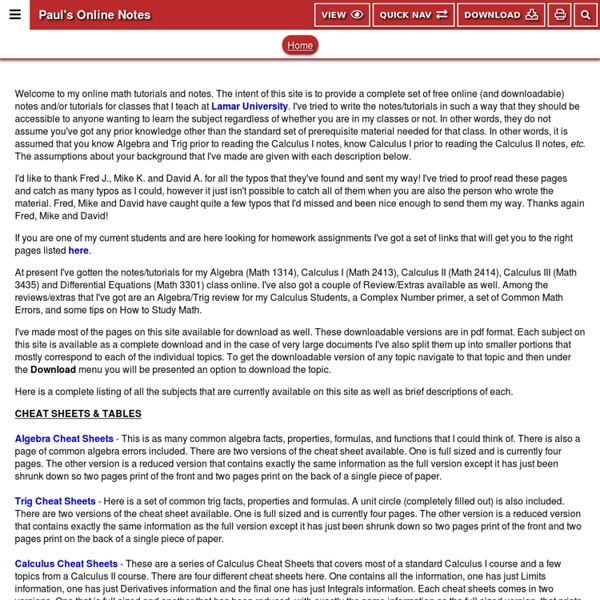Developing Your Intuition For Math
Our initial exposure to an idea shapes our intuition. And our intuition impacts how much we enjoy a subject. What do I mean? Suppose we want to define a “cat”: Caveman definition: A furry animal with claws, teeth, a tail, 4 legs, that purrs when happy and hisses when angry…Evolutionary definition: Mammalian descendants of a certain species (F. catus), sharing certain characteristics…Modern definition: You call those definitions?
6174 (number)
6174 is known as Kaprekar's constant[1][2][3] after the Indian mathematician D. R. Kaprekar. This number is notable for the following property: Take any four-digit number, using at least two different digits.
Elementary Concepts in Statistics
In this introduction, we will briefly discuss those elementary statistical concepts that provide the necessary foundations for more specialized expertise in any area of statistical data analysis. The selected topics illustrate the basic assumptions of most statistical methods and/or have been demonstrated in research to be necessary components of our general understanding of the "quantitative nature" of reality (Nisbett, et al., 1987). We will focus mostly on the functional aspects of the concepts discussed and the presentation will be very short.
Nerd Paradise : Calculating Base 10 Logarithms in Your Head
Calculating base 10 logarithms in your head on the fly is a lot easier than you may think. It is simply a matter of memorization and a little estimation... First memorize all the single digit base 10 logs. Don't worry, it's not as painful as it sounds. I even made the chart for you: Remember this rule from high school?
Math Books: Recommended books about mathematics
Countless math books are published each year, however only a tiny percentage of these titles are destined to become the kind of classics that are loved the world over by students and mathematicians. Within this page, you’ll find an extensive list of math books that have sincerely earned the reputation that precedes them. For many of the most important branches of mathematics, we’ve provided what we consider to be the best math books for the subject at hand. We aimed for a list of titles that were either introductory in nature or that fall into the category of “must-have” math reference books. Naturally a universal consensus doesn’t exit, but the books below are as close as it gets to a wish list for any aspiring mathematician or person who’s interested in mathematics.
Prime numbers
Version for printing Prime numbers and their properties were first studied extensively by the ancient Greek mathematicians. The mathematicians of Pythagoras's school (500 BC to 300 BC) were interested in numbers for their mystical and numerological properties. They understood the idea of primality and were interested in perfect and amicable numbers.
Mathematical Atlas: A gateway to Mathematics
Welcome! This is a collection of short articles designed to provide an introduction to the areas of modern mathematics and pointers to further information, as well as answers to some common (or not!) questions. The material is arranged in a hierarchy of disciplines, each with its own index page ("blue pages").
Einstein for Everyone - StumbleUpon
Einstein for Everyone Nullarbor Press 2007revisions 2008, 2010, 2011, 2012, 2013 Copyright 2007, 2008, 2010, 2011, 2012, 2013 John D. Norton Published by Nullarbor Press, 500 Fifth Avenue, Pittsburgh, Pennsylvania 15260 with offices in Liberty Ave., Pittsburgh, Pennsylvania, 15222 All Rights Reserved John D.
- StumbleUpon
The length of the polygonal spiral is found by noting that the ratio of inradius to circumradius of a regular polygon of sides is The total length of the spiral for an -gon with side length is therefore
Fibonacci in Nature
The Fibonacci numbers play a significant role in nature and in art and architecture. We will first use the rectangle to lead us to some interesting applications in these areas. We will construct a set of rectangles using the Fibonacci numbers 1, 1, 2, 3, 5, 8, 13, 21, and 34 which will lead us to a design found in nature. You will need a ruler, protractor, and compass. Start by drawing two, unit squares (0.5 cm is suggested) side by side. Next construct a 2-unit by 2-unit square on top of the two, unit squares.
Hammack Home
This book is an introduction to the standard methods of proving mathematical theorems. It has been approved by the American Institute of Mathematics' Open Textbook Initiative. Also see the Mathematical Association of America Math DL review (of the 1st edition), and the Amazon reviews. The second edition is identical to the first edition, except some mistakes have been corrected, new exercises have been added, and Chapter 13 has been extended. (The Cantor-Bernstein-Schröeder theorem has been added.) The two editions can be used interchangeably, except for the last few pages of Chapter 13.
Quadratic Equations: Quadratic Formula
Consider the general quadratic equation with .
Nerd Paradise : Divisibility Rules for Arbitrary Divisors
It's rather obvious when a number is divisible by 2 or 5, and some of you probably know how to tell if a number is divisible by 3, but it is possible to figure out the division 'rule' for any number. Here are the rules for 2 through 11... The last digit is divisible by 2. The sum of all the digits in the number is divisible by 3. The last 2 digits are divisible by 4. The last digit is 5 or 0.


